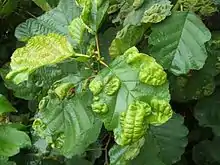Taphrina tosquinetii
Taphrina tosquinetii is a fungal plant pathogen that causes large blisters on both surfaces of the leaves of alder.
| Taphrina tosquinetii | |
|---|---|
 | |
| Scientific classification | |
| Kingdom: | Fungi |
| Division: | Ascomycota |
| Class: | Taphrinomycetes |
| Order: | Taphrinales |
| Family: | Taphrinaceae |
| Genus: | Taphrina |
| Species: | T. tosquinetii |
| Binomial name | |
| Taphrina tosquinetii | |
| Synonyms[2] | |
| |
Description of the gall
The ascomycete induces a gall that distorts the leaves of alder. The leaves are slightly thickened, brittle and incurved with blister-like growth on both sides, which can increase the size of an infected leaf to twice the normal size. Later the leaf tissue becomes pale and thin with a whitish bloom when the asci develop.[3][4] Species infected include common alder (Alnus glutinosa), grey alder (Alnus incana), Alnus x pubescens.[1]
References
- Ellis, W N. "Taphrina tosquinetii (Westendorp) Tulasne, 1866". Plant Parasites of Europe.
- "Taphrina tosquinetii (Westend.) Magnus, 1890". Interim Register of Marine and Nonmarine Genera. Retrieved 13 January 2021.
- Redfern, Margaret; Shirley, Peter; Bloxham, Michael (2011). British Plant Galls (Second ed.). Field Studies Council. p. 34. ISBN 978 1 85153 284 1.
- "Taphrina tosquinetii". fungalpunknature. Retrieved 13 January 2021.
This article is issued from Wikipedia. The text is licensed under Creative Commons - Attribution - Sharealike. Additional terms may apply for the media files.